Quilt Stories is an ongoing series of blog posts relating the history of the quilts I have made and their influence on my technique. I hope readers will find it inspiring especially to hear about how experience, experimentation, and chance have impacted my quilting.
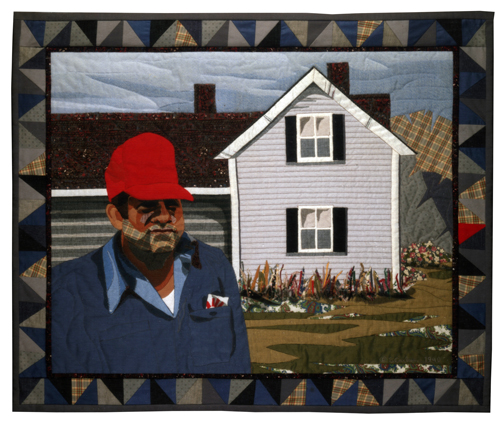
Many moons ago—shortly after the Lascaux Cave drawings, it seems now—I made a quilt portrait of my father-in-law, Dain Allen.
Dain passed away last September, on Labor Day, which seems rather fitting considering he worked for about 70 of his 79 years as a commercial fisherman.
The quilt I made of him holds many special memories, of course. But it is also a landmark piece for me. In honor of both Dain and this first blog post of the New Year 2016, I’ll relate the quilt’s own notable “firsts” in the way I have eventually come to work. It was the first portrait that I made using patterned fabric in the face, it was the first one that I free-hand cut the fabric rather than making a template, it marked the first time I used sheers to create highlights and shadows, and most importantly, it was the first piece I used my “new” fabric collage method on.
Family Portraits
I had made portraits previously, as far back as my college pre-Lascaux Cave days. I began by painting on fabric. I created portraits of my parents and maternal and paternal grandparents this way. I also did a few other portraits—one of them using satin and silk from a wedding dress my mother had designed and constructed for the bride—by drawing in the facial features with oil pastels.
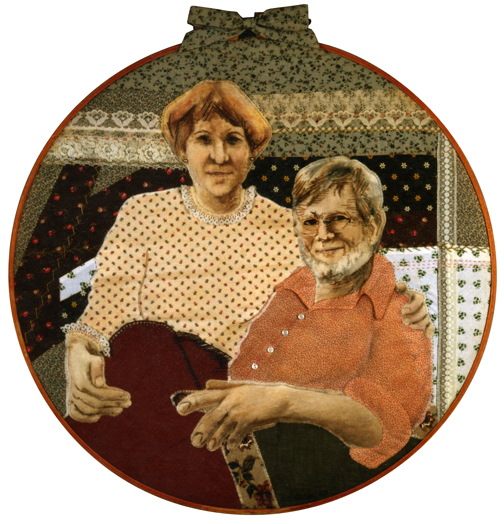

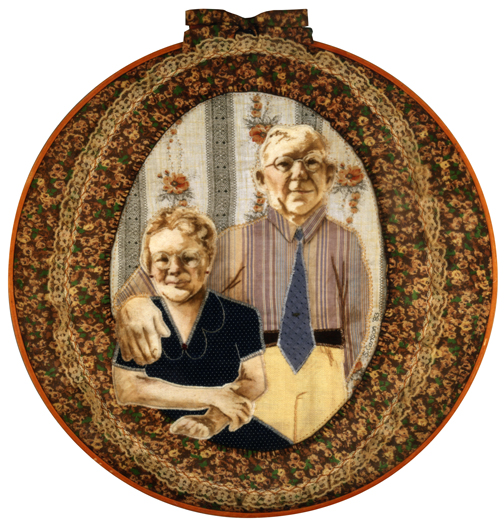
Somewhere along the way I also did a few simple portraits “drawing” directly onto the fabric with thread in a free-motion sort of way. My boyfriend-now-husband was the model for a one. Another was a self-portrait.
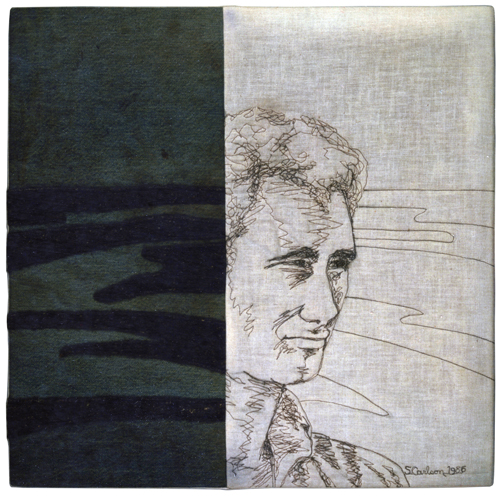
But these techniques and their products, though great for the learning curve, were ultimately not enough for me. I was on the way to my current way of thinking: “more is better.” I wanted to use fabric in a more painterly way to create portraits with more depth and feeling.
I also wanted to indulge my love (perhaps lust is not too strong a word) of fabric.
’Cause that’s what it’s all about in the end—where my career is now: providing me the opportunity to collect and use fabric. I wanted to set aside the ink pots and paint brushes. I wanted to handle fabric, cut fabric, layer it and sew it.
Throwing Away the Template
When I decided to create this portrait of Dain, I consciously chose to use only fabric to create his image. This had a couple of immediate implications.
First, I knew I would have to work in a larger format than I had before. For instance, the bridal portrait was intended to showcase the wedding dress. The head was only two or three inches across. I couldn’t begin to make facial features that small out of cut fabric pieces.
Second, the image would have to be simplified. Since I couldn’t rely on the blending that you can achieve from painting or drawing—to create the shape of a cheek, for example—somehow I would need to create that same effect by using defined shapes of fabric. Fabric after all is a solid medium rather than fluid.
Making the image larger was easy. Instead of working on a full-length portrait, I cropped the image to head and shoulders only.
I thought that I could simplify the image by creating a template. After all I had created other quilts that way. So I made a master drawing, and prepared to outline facial shapes and features onto tracing paper.
But then it struck me: Why?
Why should I go through all that work? If I could cut paper pieces a certain shape, why couldn’t I just skip that step and cut the fabric out directly? I was impatient, I guess. I was in a hurry to get to the fun part. I wanted to work with fabric, not paper.
I was already pretty handy with scissors. A couple decades later, if it weren’t for the blood, I’d be ready to perform bypass surgery. So, it wasn’t that big a stretch for me to forgo the template. I didn’t consider it that revolutionary at the time, though it eventually became an integral part to what I do and what I teach.
Throwing away the template allowed for spontaneity. It allowed happy accidents to happen (serendipity!).
Speaking of Impatience
Once I’d thrown away the template, I started looking for other ways to increase the immediacy of the process, to make it more painterly.
I had tried traditional appliqué. It’s a good technique, but time consuming. I’d tried fusible web to adhere fabric pieces down, which involves preparing the fabric first and then ironing the cut pieces in place. This technique also was not conducive to the more painterly approach I was striving for.
For “Dain” I decided to do something radical.
I reached for the glue bottle.
Now, in these current days of multi-media fiber arts, using glue is no big thing. But 26 years ago, gluing fabric onto the face of a quilt was gasp-inducing.
I used a dab of glue on each piece to tack it in place. How freeing that was! It was even quite easy to pull up and change out the fabric shapes if I needed to. Not something easy to do with appliqué or fusible.
The Piece of Fabric that Changed My Life
Previously, I’d always used fabrics that were plain (especially when you compare them to what I use now!) and usually solids for the faces. After all, I was going to paint on them. Even when I started using more than one fabric as a base, they remained solids in an effort, I suppose, to try to make the portrait realistic. But I started to see more in the possibilities of my fabric.
I’m not sure what made me lay down that piece of plaid on Dain’s chin. In the picture I was working from, Dain had a strong five o’clock shadow. Who would’ve thought that a grey plaid fabric could be used for whiskers? But in that serendipitous way, it worked.What was I thinking at the time? I wish I knew.
Because that piece of fabric changed my life.
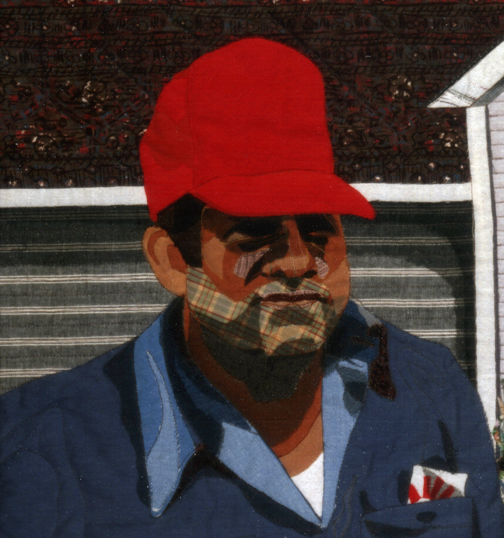
It changed the way I see. It expanded my fabric horizon. I would never look at the world or fabric the same again. It started my love of patterned fabric, which has only grown bolder and brighter in the years since.
Tulle as a Tool
That piece of plaid for Dain’s five o’clock shadow was great. But I still needed to add more definition, more contours to his face, to give shape to his chin and cheeks. How would I do that without obscuring that wonderful piece of fabric?
Okay, so I was making a quilt by using raw edge piecing. I knew from the start that before quilting I would cover the entire collage with a large piece of tulle—a final top layer—thereby further securing all the underneath fabric in place. This is called shadow quilting.
It must have been this awareness of tulle that made a light bulb go off.
This was the first quilt where I used sheers and other semi-transparent fabrics to create shadows and highlights. I used dark netting on his chin and jawline for shadows and a light organza on his cheeks and nose for highlights. These gave definition to his face without totally obscuring the plaid underneath.
Once I had that figured out, I used more netting to create shadows under the eaves and on the windows of the house. And more organza for wispy clouds in the background.
Every Quilt Tells a Story
That’s the story of “Dain.” I look back on this quilt with great fondness. I recognize how simple it is, especially compared to what I do now, but in it are the seeds of much of what I do today: the use of patterned fabric in the face, freehand cutting of fabric, the use of semi-transparent fabrics for highlights and shadows, and of course the use of glue.
And this one carries with it personal memories as well. Memories of the man who inspired it. He gave us so much. Without knowing it, he even changed the course of my career.
Thanks, Dain.

Enjoyed this trip through your beginnings. Thanks for sharing.
Amazing!
So very interesting! Thanks!
I have admired your work for ages – thank you for this lovely narrative.
Susan,
I tried to comment on your blog, but I needed a WP account. So, I’m sending it to you directly:
I love this! The quilt, of course, but more so your story of discovery and evolution. It’s both interesting and even a little exhilarating to read about your growth.
I was also struck by the skills you had in place before getting to this point. Clearly, your ability to paint portraits gave you the “seeing†skills you needed to compose Dain’s face without templates.
Thanks for posting!
Ellen Lindner
Fabric collage website: http://www.adventurequilter.com
Art and creativity blog: http://adventurequilter.com/blog/
Ellen,
Somehow your comment ended up in the right place, so thanks for the effort. Thanks for the kind comment.
Susan
I love that plaid, and the quilt. You are a true artist and I really appreciate the thought process.
I have enjoyed your blog so very much! I plan to jump in with both feet and give the turtle pattern a try this year. With every blog I learn a new tool to use for a totally newbie! I tried to get in to your class in St. Augustine but did not hear back from the guild, so I assume it is full. I so admire your talent!!
Hi Susan: Knowing Dain as I did — and as you know also being a commercial fisherman and painter — I really appreciated many aspects of both the article and of that quilt. I looked at the plaid before you explained it and said to myself that it was really brilliant for you to do that. Thank you for writing this.
Thanks, Tom. It’s special to hear back from those who knew him. Good luck with the rest of the season. Just so you know, because you know my Tom, he and collaborate on this blog, so many of the sentiments are shared by him.
Thank you so much for your stories. I’m learning something new in each post and appreciate it very much.
Lynda
This post moved me a great deal and helped me to understand the subtlety and power of Darlene’s own quilt making, and how much she has learned from you about life and art. Thank you, and please do more! Also, I can see a podcast flowing from this generous sharing of your creation process. It would be a chance for your followers to hear your voice as you talk informally about your art, perhaps recorded in your studio as a way of thinking out loud about something that has you stuck, or delighting in a breakthrough. I happen to know a guy who would be glad to help with the audio and podcast setup! 🙂
This was so informative. I have wanted to do a portrait for so long. This may get me out there. Thank you.
Sent from my iPhone
>
Wonderful story Susan and I love getting your blog. It is so full of information. I look forward to learning more about you and your quilting life. Julie
Thanks, Julie. I’m glad you’re finding it useful.